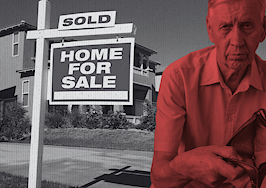Brian Evans thought his clients were going in with a strong offer.
Evans, a Redfin agent in the Washington, D.C., area, told Inman he was recently working with buyers who wanted a home that was listed for $850,000. Homes in the area have in the past sold for around 10 percent over their asking prices, so when his clients offered $150,000 over it seemed like they’d be strong contenders.
They weren’t.
Instead, the home ultimately generated 14 offers and sold for a whopping $230,000 over its asking price. What had seemed like a strong offer had in the end only put Evans’ clients “in the middle of the pack.” They weren’t even close to winning.

Brian Evans
“When you’re blown out by $80,000, it’s crushing,” Evans said of his clients. “But there’s nothing you can do. You feel flattened.”
A year into the coronavirus pandemic, “flattened” appears to be the operative word. Finally, infections and deaths are down, the curve is flattening and there’s hope that life and the economy are inching back to normal. But in real estate, a persistent lack of inventory that has been a long-running problem is now colliding with the spring buying market — amplifying a housing shortage to heights many agents have never before seen in their careers.
Case in point: “Inventory is as low as I’ve seen it for a spring market in the six years I’ve been practicing as a real estate agent,” Evans said. “This spring has really just blown things out of the water.”
To better understand what’s going on, Inman reached out to consumers, economists and agents all across the country. The picture they painted is bleak; the shortage appears to be widespread and has become soul-crushing for both people buying houses and the agents representing them. The causes of the problem are complex and predate the pandemic itself, but the ultimate takeaway is that while the current level of intensity may subside a bit, there’s likely to be a supply shortage for some time still.
Here’s what you need to know:
Table of Contents
Why are there no homes for sale in America?
Data provided to Inman from several different companies offers a staggering view into the current housing shortage.
For example, Redfin found in late March that 39 percent of homes during the prior four weeks sold above their listing prices. That was an all-time high, and was 15 percentage points higher than what was happening during the same period one year earlier.
Data from Zillow further shows steep declines in the number of for-sale listings over the last year. Especially noteworthy in this data is the fact that these steep declines are new; as recently as spring of 2019, the number of listings was actually up compared to prior months and years.

Credit: Jim Dalrymple II via Zillow data
Jeff Tucker, a senior economist for Zillow, told Inman that the roots of this current inventory shortage date back more than a decade, when housing construction mostly stopped in the wake of the housing bubble collapse.

Jeff Tucker
“Ever since 2007, we were radically under-building,” Tucker explained, “especially single-family homes.”
Among other things, Tucker explained that the construction industry depends in some areas on migrant and immigrant workers. However, as the sector dried up many of those workers returned to their home countries and never came back. Other workers also found jobs in different industries, such as energy. The result was a labor shortage that has continued to hamstring the construction industry right up until the present day.
To make matters worse, this period of underproduction has also coincided with unprecedented demand. Danielle Hale, chief economist at realtor.com, explained that millennials are the largest generation since the baby boomers and have been gradually hitting homebuying age in recent years. That trend is peaking right now.

Danielle Hale
“The largest chunk of the millennial generation is hitting 30,” Hale explained. “I think that’s one of the things that has really created this tipping point. You kind of have this perfect storm of factors coming together to really make the housing market unlike what we’ve seen in recent years.”
And of course, there’s the pandemic, which spurred many people to move to bigger houses or to new locations.
“A lot of office workers in the upper third of the income distribution were doing fine and had more disposable income than in a normal year,” Tucker said, “and also had a need for space.”
Many such consumers have helped drive up housing costs, in part because fewer existing homeowners have been listing their houses.
“Usually the way market economies work is, if you don’t have enough of something, the price goes up and that incentivizes people to produce more,” Hale said. “In this case, it should incentivize homeowners to sell their home.”

Additional resources:
- Inventory insanity: Why are there no homes for sale in America?
- How to win a bidding war
- March was the hottest month in housing history
- What’s driving the real estate inventory crisis? These 5 trends
- US inventory plunges to all-time low
- Pending-home sales dip for 4th consecutive month
What it’s like to be an agent in an extreme inventory shortage
Agents are having a tough time out there.

Jill Stencil
Jill Stencil, an agent with Legacy Premier Realty in Cape Coral, Florida, told Inman she recently had a listing that got nine offers within 24 hours of it going live. She’s seen homes in her market go for as “little” as $30,000 over their asking prices, and for as much as $100,000. And she’s had to write offer after offer for clients, even when she knows they’ll keep getting beaten.
“People are crying,” she added of her buyers who have lost over and over.
Rebecca Nemeth, of Zip Code East Bay in Oakland, California, told Inman that buyers with huge amounts of money have been flooding into her previously somewhat-more-affordable area.
“We’ve always had more demand than supply,” she explained. “What’s changed is that we have some buyers who have inordinate amounts of money. But we also still have normal humans who want to live here.”

Kerrian Latty
And Kerrian Latty, an agent with Equity Realty Group in Trumbull, Connecticut, said “this market is the craziest market I’ve ever seen.”
“Half the battle is educating our clients on how to bid now and telling them they have to block out the norm of trying to get a good deal,” Latty told Inman. “After you do that half, then you’re just trying to get your offer in. You’re praying that the listing agent is truly presenting all these offers.”
The point is that agents are having to work harder and stick with clients for much longer periods in order to win bids. Other agents described to Inman having to spend 12 hours every Saturday showing clients around, writing offers on homes sight-unseen, and trying but failing to convince buyers that the market has shifted dramatically in the last few months.

Tiara Smith
The situation is having a major impact on agents. Tiara Smith, for example, is typically a buyer’s agent, and explained that this year that means working with clients for much longer because it’s so difficult for them to actually get a home. It’s exhausting.
“They want to go on these showings every day, day in and day out,” Smith, a Keller Williams agent in Columbia, Maryland explained. “It’s our duty to do our best, but I also have a family. I can’t do showings 24/7. We’re having a hard time, too. We’re human.”

Additional resources:
- Inventory insanity: Notes from ‘exhausted’ agents on the front lines of a crazy market
- How this agent is helping migrating buyers find their dream homes
- Feeling overwhelmed, exhausted or distant? 8 ways to combat burnout
- The real estate industry added 10,000 jobs in March
- 3 strategies to find listings in inventory-starved markets
The secret economic forces fueling the housing shortage
In addition to demographics and pandemic-induced buying trends, there are several other more subtle reasons housing is getting more expensive right now. One of those reasons is that the cost of materials such as lumber is shooting up.

David Logan
David Logan — a senior economist with the National Association of Home Builders (NAHB) — explained that the price increases happened because manufacturers anticipated a “precipitous drop in housing demand” that ultimately never materialized.
“Producers of lumber, they shut down like most every other business needed to,” Logan told Inman. “But when production came back, mills had curtailed their production by as much as 50 percent.”
Logan called this a “fatal mistake” on the part of lumber companies, and the result is a kind of triple whammy where supply is low, while demand from both contractors and everyday consumers is higher than ever.
“I would say it’s certainly unprecedented in so far as a surge of demand unexpectedly coincides with a large decline in supply,” Logan added.

Credit: U.S. Bureau of Labor Statistics via NAHB
At the same time that materials are getting more expensive, investors have also flocked to the market, increasing competition for everyday consumers.
Rick Palacios Jr., director of research for John Burns Real Estate Consulting, told Inman that right now investors are buying 20 percent of all homes in the U.S. Asked if that was enough to sway prices and housing supply, Palacios answered without hesitation: “yes.”

Rick Palacios
“That percentage gets even higher in a lot of markets,” he added. “Almost a quarter of all housing transactions are going to investors.”
Palacios went on to say that “there’s a global quest for yield” going on among investors right now. At the same time, yields from vehicles like U.S. Treasuries have tanked while investment in commercial real estate became unappealing thanks to COVID-related shutdowns of stores, restaurants and hospitality businesses. Residential real estate, and especially single-family housing, looks relatively safe by comparison.
“Today’s investors are investing for both quick appreciation as well as yield and safety compared to other alternative investments,” Palacios added.

Additional resources:
- Inventory insanity: The secret economic forces fueling the housing shortage
- The Essential Guide to Wall Street and real estate
- Homebuilders can’t catch up with demand
- Builder confidence on the up and up
What it’s like being a homebuyer when there are no homes to buy
Inman spoke with two homebuyers about their experience looking for properties in recent months. The first, Lauren Wasteney, has been looking in the Bay Area. Her budget topped out in the high $400,000 range, and she explained that while she would have liked to save for a few more years, she ultimately decided to move forward because interest rates are so low.
Wasteney told Inman the first home she zeroed in on was listed for around $460,000. She knew she would have to offer more than the property’s asking price, and $475,000 seemed reasonable to her.
But that price was a nonstarter: Before Westerly could even submit an offer, her agent called and revealed the seller had already received offers for more than $500,000. Westerly ultimately gave up on the property and never sent her offer in.
“It was more of a derailed sort of offer,” she said.
Wasteney eventually moved on and found a condo in Richmond, at the northern tip of the San Francisco Bay. It was listed for $450,000 and seemed promising because most lenders wouldn’t finance a loan on the property — meaning the competition should have been less fierce. On top of that, the condo was located a short distance from Wasteney’s work, making it even more attractive to her.
She ultimately offered $480,000. She spent a week agonizing without hearing back. And then, she lost again.
“I didn’t necessarily expect to be accepted,” she said, “but it’s always still a punch in the gut. You do start imagining yourself in it.”
When she spoke to Inman, Wasteney had still not found a home.
Another buyer, who asked not to be publicly identified, spent months looking in Austin, Texas. The would-be homebuyer had a friend who sold a property in a condo complex 18 months ago for just under $390,000, so she began her home search last fall in that same complex.
Very quickly, however, the woman had a rude awakening: A unit comparable to her friend’s was now listed for $499,000.
“I was just kind of going, ‘oh my gosh, wow,’” she said.
The woman continued to watch prices rise and rise, and when she spoke with Inman she said she was “to the point where I’m about to give up on Austin.”
The woman did eventually find a property to buy in Houston, but there, too, competition was fierce and she only succeeded because she had a friend who lived in the neighborhood and got the inside scoop on a soon-to-list home.

Additional resources:
- Inventory insanity: What it’s like being a homebuyer when there are no homes to buy
- My journey through inventory hell had a fairy tale ending
- Homes have literally never been more expensive
- A house in Washington, DC, nabbed 88 offers — 76 of them all-cash
- More than 1 in 5 Americans moved or know someone who moved during the pandemic
When will the supply shortage end?
The important thing to keep in mind amid all of this craziness is that “inventory” is a measure of the balance between supply and demand. For example, if the number of homes on the market suddenly doubled, there’d be more supply. But if the number of hopeful buyers quadrupled at the same rate, all those new listings still wouldn’t be enough. There’d be an inventory shortage. And that’s basically what’s going on right now: Demand is outpacing supply.
That’s also why data that the National Association of Realtors (NAR) provided to Inman projects a total of nearly 6.5 million existing home sales in 2021. That’s up significantly from just 5.64 sales in 2020, but because demand is high it still isn’t enough.

Matthew Gardner
This matters because the current shortage can either resolve by increasing supply or decreasing demand.
“The only way we can really fix this is we’ve got to build more,” Matthew Gardner, chief economist for Windermere Real Estate, told Inman.
Rising labor and material costs make the building option challenging though, and while contractors are catching up, Tucker, of Zillow, said he thinks “it will take several years to meet this excess demand.”
On the flip side, rising mortgage rates may also curtail demand. According to NAR’s projections, average 30-year fixed interest rates should hit 3 percent in the second quarter of 2021, and then ultimately rise to 3.3 percent by the second quarter of 2022. These are still great rates, but they are higher than the average of 2.8 percent in the fourth quarter of 2020, and that will translate into higher monthly payments for consumers.
“Mortgage rates have enabled prices to rise so much without hitting consumers in the pocketbook,” Hale, of realtor.com, explained. “But now we’re starting to see mortgage rates turn around and consumers just won’t be able to have the same spending power that they had before.”
Gardner ultimately said affordability could also come into play, with many consumers eventually hitting the limits imposed by their incomes. He ultimately envisions some relief in 2022 or 2023, though all of the economists who spoke with Inman indicated a shortage in some form or another will likely linger for sometime.
“We haven’t seen the peak,” Gardner concluded. “This year is going to be a very frustrating year for homebuyers.”

Additional resources:













